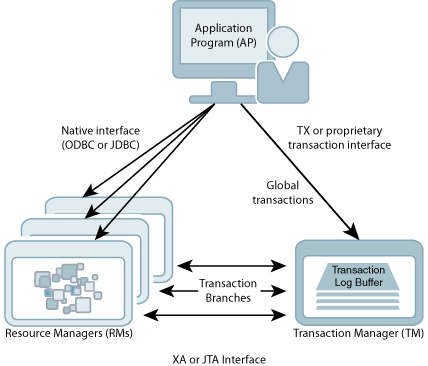Overview of XA
This section provides a brief overview of XA concepts.
X/Open DTP Model
Applications use the TX interface to communicate with a transaction manager. In the DTP model, the transaction manager breaks each global transaction down into multiple branches and distributes them to separate resource managers for service. It uses the XA interface to coordinate each transaction branch with the appropriate resource manager.
Figure 6-1 that follows illustrates the interfaces defined by the X/Open DTP model and shows an application communicating global transactions to the transaction manager.
Figure 6-1 Distributed Transaction Processing Model

Description of "Figure 6-1 Distributed Transaction Processing Model"
Global transaction control provided by the TX and XA interfaces is distinct from local transaction control provided by the native ODBC interface. It is generally best to maintain separate connections for local and global transactions. Applications can obtain a connection handle to a TimesTen resource manager in order to initiate both local and global transactions over the same connection. See TimesTen tt_xa_context Function to Obtain ODBC Handle From XA Connection.
Two-Phase Commit
In an XA implementation, the transaction manager commits the distributed branches of a global transaction by using a two-phase commit protocol.
-
In phase one, the transaction manager directs each resource manager to prepare to commit, which is to verify and guarantee it can commit its respective branch of the global transaction. If a resource manager cannot commit its branch, the transaction manager rolls back the entire transaction in phase two.
-
In phase two, the transaction manager either directs each resource manager to commit its branch or, if a resource manager reported it was unable to commit in phase one, rolls back the global transaction.
Note the following optimizations:
-
If a global transaction is determined by the transaction manager to have involved only one branch, it skips phase one and commits the transaction in phase two.
-
If a global transaction branch is read-only, where it does not generate any transaction log records, the transaction manager commits the branch in phase one and skips phase two for that branch.
Note:
The transaction manager considers the global transaction committed if and only if all branches successfully commit.